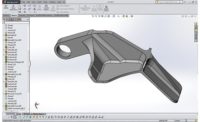Asher Breverman is a one-person manufacturing advertisement.
If more people talked to him, it seems that more of them would be interested in manufacturing. He feels lucky to have found a career at a medical device manufacturing company working on 3D printing.
But beyond the technology, Breverman is motivated by the larger purpose involved in his work, bringing spine surgeons’ ideas to life. “It’s been an unparalleled experience and opportunity for me,” he says.
While Breverman is an enthusiastic new addition to the manufacturing workforce, companies are finding it increasingly difficult to attract and hire others like him.
State of the Industry
The United States ranks as one of the top manufacturing locations in the world. According to Brookings Institution’s Global Manufacturing Scorecard released in July, the United Kingdom and Switzerland were the top ranked nations in overall manufacturing environment (both with 78 points out of 100). However, the United States was just behind with 77 points. These rankings were the result of policies, cost considerations, workforce investments, and infrastructure, according to the organization.
Despite this strong environment, manufacturing can still seem like a tough sell.
If your company finds it difficult to attract and retain a strong workforce, you are not alone. According to the National Association of Manufacturers’ second quarter 2018 Manufacturers’ Outlook Survey, “For the third straight survey, the inability to attract and retain a quality workforce was the top business challenge for manufacturers, cited by 76.7% of respondents.”
But if you are not doing anything about it, you are in the minority. According to the survey, two-thirds of respondents said they plan to increase apprenticeships, training and/or other mentoring programs in the next year.
Apprenticeships are one of the top ways to recruit the next generation, according to Jeffrey Forrest, vice president, economic and workforce development, College of the Canyons (Santa Clarita, CA), who spoke to the House small business subcommittee on contracting and workforce earlier this year.
In order to attract the next generation of employees, manufacturers have plenty to do. Forrest suggests employers should form consortiums of about 20 companies to create leverage and a greater voice. Companies may think that if they reveal their workforce issues to competitors, it may make them vulnerable. But “it’s the opposite,” Forrest says. “It makes them more powerful.”
He also suggests talking to post-secondary colleges in your region, in order to get involved with manufacturing education and curriculum. In addition, working well with current employees can also be a boon to workforce recruitment.
If manufacturers have a welcoming culture, provide training to new employees and offer a clearly defined career path, this can enhance loyalty among employees. In turn, they will tell their friends and family about opportunities at the company.
“If they really want to turbocharge recruitment at very low cost, treat the employees like people,” Forrest says. By spreading the message that the company wants people to develop and grow with the company, it is easier to retain employees and recruit new ones.
Promoting an interest in manufacturing for students in middle school and high school can also pay off. He described a program in Sacramento where high school students are working with local companies over the summer to learn advanced manufacturing.
In addition, there is a growing undercurrent of community colleges working more closely with employers, Forrest notes, including at his employer, College of the Canyons.
The College of the Canyons is also partnering with Tooling U-SME to help small businesses train their existing employees.
Jeannine Kunz, vice president of Tooling U-SME, says that manufacturers are increasingly aware of workforce issues. “We’ve seen a trend in more involvement and awareness,” says Kunz. Manufacturers are starting to recognize that the next generation is also part of their supply chain, she says.
“As a manufacturer, you wouldn’t sit back if you had a problem with your supply chain with a component, you would do something about it,” Kunz says. In the same way, companies should be proactive with recruitment.
“The problem is not going away,” she says. “A lot of those baby boomers are in a better position to retire. That reality is going to hit. We anticipate that manufacturers will continue to increase their engagement in schools, helping to change perceptions.”
A Larger Purpose
Breverman was always interesting in building things—or breaking them—and wanted to go into engineering. At first he considered civil engineering, but he decided to go into mechanical engineering during college once he learned more.
After graduating from Drexel University with a master’s and bachelor’s degree in mechanical engineering with a focus on additive manufacturing and rapid prototyping technologies, Breverman joined Osseus Fusion Systems last year.
He found his current position after interning at medical device companies as part of Drexel’s built-in engineering program. This allowed him to get exposure to medical devices and 3D printing as well as build his skillset.
Even at this early stage in his career, Breverman wants to give back and introduce others to manufacturing opportunities. When he attended this year’s RAPID show in Dallas, he got to know SME and America Makes.
For companies who are looking to recruit young people to manufacturing, Breverman says, “One of the things I’ve noticed, not just prevalent in manufacturing, but in industry in general, is a focus on the what, rather than a focus on the why. A lot of people look at manufacturing as just the physical process of making things. For others, it’s a fulfilling opportunity to accomplish goals.”
Bringing products to life is an exciting opportunity, and companies should provide context for the employees, he says. By focusing on the context for a project, and providing a continuous skillset, companies will be in a better position to recruit and retain new staff.
On the Plant Floor
Accurate Gauge & Manufacturing provides a good example of how to go about the training process.
Allen Cookenmaster, training coordinator at Accurate Gauge (Rochester Hills, MI), spent 17 years in the machine shop, and for the past three years he’s been in charge of training.
In 2015, Accurate Gauge hired two-thirds of their workforce, and the company of 170 people continues to grow.
They’ve placed ads online and in local newspapers, and gone to job fairs, but word-of-mouth has often been their biggest source of recruitment. They’ve also taken local students on plant tours to show them the possibilities of a career in manufacturing. “Manufacturing is still here,” Cookenmaster says. “We need to do this in America, and we are doing it.”
They’ve also worked with local universities and hired students. The struggle is that they can’t hire 30 people at once and train them effectively.
For those who have never been exposed to a manufacturing plant, the job does not always fit their impressions. “Those who have never been in a factory environment are really shocked by all the different tasks we do that are required by this job,” Cookenmaster says. “During training, it’s a steep learning curve, but I try to remind them, ‘Think of your first few days and how far you’ve come.’”
They thought they would be putting a part on a machine, pushing a button, and then taking it off the machine, he says, but it’s much more than that. However, he explains that it is very understandable and doable. They are also working on a work cell area with several machines and skills. This would streamline the training process, helping both the company and the employee. Instead of trying to cram 20 years of experience into three weeks, the employee would focus on a few skills at a time.
This differs from the scene on the manufacturing floor when he started. Back then, there might have been just 10 people on a shift, and someone would help you and check on you in between doing their own work. The jobs were not quite as detailed and demanding, he says. When problems did occur, you learned things the hard way.
Though manufacturing has changed, the need for a strong workforce has not. As manufacturers continue to recruit the next generation, they would do well to work with other manufacturers who are facing the same issues, along with local schools, workforce development boards, and government, to promote the message of the opportunities in manufacturing.
“There are still a lot of new things to be done,” Breverman says. “We’re not done with making things, there are always boundaries to be pushed and new things to discover.” Q




